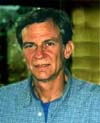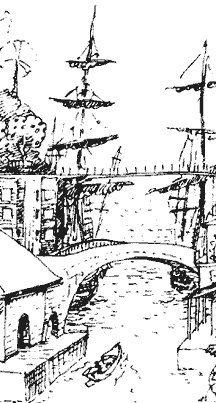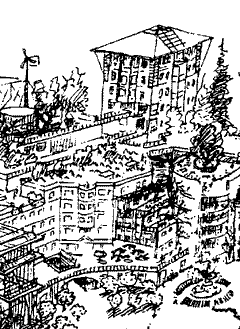BUILDING ECOCITIES:
An Interview with Richard Register
Part three of a three-part series - Page 3 of 3
In this third of his three-part interview with ecoTECTURE, EcoCity designer and builder Richard Register discussed his efforts to rebuild his home town of Berkeley, California, as an ecocity.
(To learn more about Richard Register and his work in EcoCity design, see Part One of his three-part interview with ecoTECTURE in our January / February, 2000 issue.)
ECOTECTURE: What, by the way, is your take on the Gaia building? An architect friend of mine mentioned that building when I was on my way over here. Were you involved in its design?
RR: I was involved in it in a lot of ways. I tried to make it a much more ecologically oriented building when it came before the various commissions and the zoning board. I like the idea of higher density, as did the developer. They generally like higher density because they make more money. I wanted to see design changes that would use terracing facing the sun so the building would become a passive solar building. So I proposed that the top three or four floors be terraced toward the south. You can always put up awnings or wind screens as needed to make carefully modulated (mini) climates that are really nice and look good, with trellises and wisteria, or whatever, growing up there. I thought also the aesthetic would be really exciting—an ecological aesthetic.
The Berkeley Architectural Heritage Association and the neighborhood associations, people who are against any development higher than four or five stories, categorically and vigorously opposed the building at the height I was advocating. Nonetheless, the City Council felt that the density was appropriate that close to transit. They asked the Zoning Board and the Design Review Commission to try to see that the building was designed to their satisfaction but remained at the higher density and that it would respect some of the ecological ideas that some other people and I had been hammering on.
When the project went to the Zoning Board, they took the building and turned it the wrong direction. They did that because they didn't want the high side of the building up against the street on the north, because they had a categorical notion that a tall wall next to a street makes the street a horrible place, putting it in shadows.
Well, that depends on a lot of factors. If the street is constantly filled with cars for the rest of its existence, that's one thing, but if it becomes a pedestrian street at some time, that's very different—most of the popular pedestrian streets in the world are in shadows. They are usually narrow streets among buildings that are at least two or three stories high. It is like that in cities all over the world, and nobody finds shadows horrendous in those locations. What's the big deal here in Berkeley about shadows on the street? Trees cast shade—that's good. Buildings cast shadows that's almost an evil here.
Anyway, because of their preconceptions, they turned the building around facing the wrong direction (away from the sun). It certainly will function well in relation the city, with people living close to transit. It creates 90 more units in a city that has denied new housing to its people for 25 or 30 years.
ECOTECTURE: Once you mentioned to me the idea of having a residential apartment building that would not have any car owners living in it.
RR: Car-free housing. It is an idea I've been pushing for two years. I don't know if I came up with it or if it was just sort of out there in the ether. What I meant by car-free housing is that you wouldn't be allowed to own a car if you lived there. You would sign a contact. If you violate the contract, well, you decide to buy a car and you move. People move, it's no big deal. But it has to be a legal arrangement.
That idea was actually picked up by a developer in downtown Berkeley for a building across the street from the Gaia building, the Oak Court Building. The developer, Avi Nevo, actually offered to make this a car-free building in a legal sense. He would simply recruit the people who wanted to live without cars.
I think it's a brilliant idea, because if you don't need to build the parking places for the cars you can save about 20 percent of the cost of a new building. That should be shared between the developer, the owner, and the tenants. It could make for slightly cheaper housing.
ECOTECTURE: You might even save 20 per cent of the space occupied by the new building if you think about how much room cars take up.
RR: Instead of providing parking on the ground floor, Nevo was offering to have shops and a passage way going through the block into the back alley which connects with Trumpetvine Court which is a really nice pedestrian area. The architect who is doing the building, whose name is Jim Novesel, loves pedestrian features like this.
Well, the City Council voted against it—the so called liberals and the green party member voted against it—because it would stretch the zoning ordinance. One of our city council people, Chris Worthington, told me that you can't just give this deal to this particular developer.
I said, "No, you give it to all the developers from now on. If you have to write a provision for car-free housing in the zoning law, you write it."
The Council about two weeks later turned around and wrote a new Zoning law for (the organization) Urban Ore when the recycler wanted to move into an area where the zoning was inconsistent with its work. That was the end of car-free housing in Berkeley for the foreseeable future. That was a real disaster as far as I'm concerned.
ECOTECTURE: You were involved also in the reconstruction of Berkeley's Milvia Street. You were part and parcel of designing that street for a more pedestrian friendly use. When was that project?
RR: I was part of a group of four or five who started thinking about it in 1979. We organized thirty five people in our neighborhood including about ten of us from Urban Ecology. We researched some very early street calming projects. The only ones we had heard of that were similar (to our Milvia Street idea) were in Australia. They called them "slow ways."
At first we thought about slowing down traffic by legal means—setting a speed limit of 15 miles per hour. Some of us had read a book called Energy and Equity, by Ivan Illych, in which he pointed out that as you accelerate beyond 15 miles per hour, you start doing more and more damage and there is less and less equity and "conviviality." (Reading) that made me think that slow speed was the crucial element, so I proposed the name, "slow street," which seemed to stick.
Our 35 people took a petition around the neighborhood, and 90 percent of the people signed on. It was a very popular idea because it would make the street quieter and more pleasant. We brought it before the planning commission, transportation commission, and energy commission of the City of Berkeley. They all supported it. They City Council supported it. They instructed the head of planning and transportation to move on it, and she stonewalled it. We didn't know what she had done. She just put it at the bottom of her list of things to do, and about a year-and-a-half later we started investigating and discovered that she had given it as low a priority as she could.
She did this two times, stalling about seven or eight years. Finally, we got the City Council to move on it a third or forth time, I forget which. That time we managed to finally get it done. It took ten years—a slow street in another sense.
ECOTECTURE: Do you know why she stonewalled it? Was she against it as an idea?
RR: I think she thought it was new and different and weird. It wasn't standard fare. You hear this about bureaucracies constantly. They take the easy way out and do the standard thing. That is exactly what she did. It slowed us down and stopped us several times. We had to educate new commissioners every time we went back, because a couple of years would go buy and there would be a whole different set of appointees. We would have to convince them all over again. We did it three times (laughs).
ECOTECTURE: What was the net result of all this effort?
RR: We got seven blocks of Milvia Street rebuilt so the traffic meanders from one side of the street to the other (to move around street-edge planting strips) somewhere in each block. Almost all the neighbors like it and enjoy the quieter street. The trees we added make it feel more intimate and cozy.
The speed bumps that one neighbor insisted on work well (to slow traffic) but seem heavy handed to me. We always wanted more than seven blocks and don't really feel the design was applied over a long enough distance to shift a lot of people out of cars and onto bikes. We were tired out by the repeated battles and, other than a few interviews of residents and bicyclists, there was no follow up. However, most people have reported they like the street and it is slightly slower, safer, and quieter than most.
ECOTECTURE: What lessons have you learned from your years of trying to bring the principles of ecological design to the city?
RR: It is hard to transform cities! Habits are very deep. They are built into the very structure of the city, sprawled out and automobile dependent. I've known about ecocity design ideas for thirty years. During that time cities have gotten far worse, much more automobile dependent, much more energy consuming. The third world is following in our footsteps, trying to copy America. I've traveled on all the continents giving talks, and I see people everywhere trying to buy cars, spread out, get little houses—it's a disaster, it's gigantic.
We've known a lot of thing we should have been experimenting with. It has been very hard to do those experiments. To me it is absolutely a national disgrace that Paolo Soleri still late at night is carving his little wind bells to make the money to run his entire operation. That craft funds Arcosanti, one of the most important experiments you could conceive of.
Other people could do it, but they really aren't trying to build the free standing, strictly pedestrian city that he is. That experiment is extraordinarily important in this world, and it's not being funded. He doesn't have any foundation funding—he's tried. He's tried to get government funding. To me, it is just outrageous that in the richest country in the world somebody is trying to produce a modest model of a three dimensional pedestrian community that is free of the horrors of automobiles, freeways, all the crashes they cause and the atmospheric change of the whole planet, and the guy can't get any money to do it. Similarly, in a much less conspicuous way, I'm out there trying to do something similar and confronting the same problems.
So, it has been difficult. Thirty of years of my life, so far, in this field. I see other people trying but they usually give up pretty quickly. Some do little pieces of it, and that can be done. You can build a solar greenhouse. If you want to work for a city, you can work on its transit systems and try to make it better. If you are a bicycle activist, you can get bikes on BART or build shelters to park them. If you are a gardener, you can grow more food and have it be more nutritious. But the pulling together of all those pieces into a built environment that makes some kind of sense is severely neglected.
I don't know what to do about it. I do everything I can to try to create an atmosphere where people's minds open up and they are willing to experiment, but it is very, very difficult.
ECOTECTURE: What is it that keeps you going?
RR: I don't really know. People ask me this sometimes, and, I think, in a way, I'm unemployable at anything else. If something makes some sense, I can't go against it.
It wasn't OK for me to be against the war. My mother hated me for being against the Vietnam war. But it was wrong, as far as I could tell. All the evidence pointed in one direction. So I spent years working against that war.
All the evidence points to the city making sense if it is much more compact and pedestrian oriented, covers much less land . . . ecological cities just make sense. To have seen that and say, "Well, I'm just going to do something else, when I know this is a pivotal issue and the ecological city would be the solution" —to do something else under this circumstance is for my life to have been kind of pointless. I've seen the light, in this way, maybe I've been blinded by it and I can't see properly in other regards. I do know this can solve lots of problems absolutely sure of it. When you get that kind of conviction and you are the kind of person I am, you just don't stop, I guess . . . unemployable in any other activity . . . (laughs).


